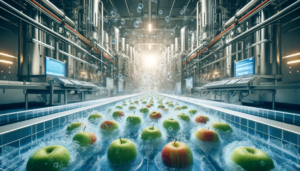 Apple washing, a critical step in post-harvest processing, presents significant challenges. Apples, transported directly from orchards, often carry soil, organic debris, and microorganisms on their surface. During washing, these contaminants dissolve in the water, leading to increased bacterial loads and suspended solids.
Apple washing, a critical step in post-harvest processing, presents significant challenges. Apples, transported directly from orchards, often carry soil, organic debris, and microorganisms on their surface. During washing, these contaminants dissolve in the water, leading to increased bacterial loads and suspended solids.
The traditional approach relies heavily on water circulation, but over time, water quality degrades. This necessitates frequent replacements to maintain hygienic standards, resulting in high resource consumption and operational downtime. Beyond the visible contamination, the microbial presence accelerates fruit deterioration, impacting product quality and shelf life.
The Role of Ozone in Revolutionizing Apple Washing
Ozone, a powerful natural disinfectant, offers a sustainable and efficient solution to these issues. Unlike conventional methods that employ chemical additives or rely on complete water replacement, ozone technology disinfects water without leaving harmful residues.
In industrial settings, ozone is generated by passing electrical discharges through oxygen or air, creating a molecule with potent oxidizing properties. This molecule destroys bacteria, viruses, and other pathogens, ensuring water remains clean throughout the washing process. Importantly, ozone decomposes into harmless oxygen, making it environmentally friendly.
Benefits of Ozone-Based Apple Washing
Reduction in Water Usage and Waste: Ozone systems enable the continuous purification of water, allowing its reuse over extended periods. This minimizes the need for frequent water replacement, significantly cutting down on water consumption.
Improved Hygiene and Product Longevity: By eliminating microorganisms, ozone prevents contamination of apples during washing. This leads to extended shelf life and improved quality of the fruit.
Operational Efficiency: Continuous water purification reduces the need for frequent downtime to replace or treat water. Facilities can operate uninterrupted for longer periods, enhancing productivity.
Eco-Friendly and Cost-Effective: Ozone treatment systems require less energy and maintenance compared to traditional methods. The absence of chemical additives further reduces environmental impact and associated costs.
Implementation in Industrial Apple Washing
Ozone treatment plants designed for apple processing operate using compact vertical systems. These systems utilize ozone microbubbles that rise through the water, efficiently disinfecting it and preventing the buildup of algae and bacteria. Advanced monitoring systems ensure precise ozone levels, optimizing water quality and process efficiency.
Conclusion
Ozone technology represents a breakthrough in apple washing, addressing the dual challenges of contamination and sustainability. By ensuring cleaner water and reducing resource consumption, ozone systems support high-quality apple production while aligning with environmental goals. This innovative approach not only enhances operational efficiency but also sets a new standard for sustainability in the food industry.